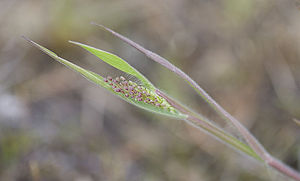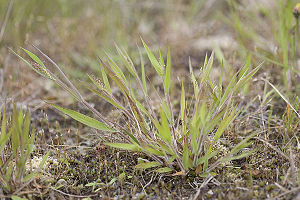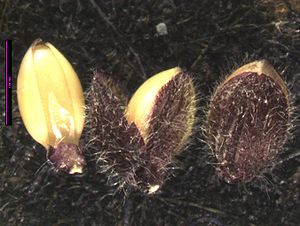Dichanthelium acuminatum
- Scientific Name: Dichanthelium acuminatum
- Family: Poaceae
- Common Names: hairy perennial panicgrass
- Codon: DICACU
Contents
Taxonomy
| Scientific classification | |
|---|---|
| Kingdom: | Plantae |
| Subkingdom: | Viridiplantae |
| Phylum: | Tracheophyta |
| Subphylum: | Spermatophytina |
| Class: | Magnoliopsida |
| Subclass: | Lilianae |
| Order: | Poales |
| Family: | Poaceae |
| Genus: | Dichanthelium (Hitchc. & Chase) Gould |
| Species: | Dichanthelium acuminatum (Sw.) Gould & C.A. Clark |
| Synonyms | |
| |
Description
Tufted perennial grass with broad, open panicles, finely-haired,[2] growing to 40 cm tall.[3] Culms hollow, simple in spring, branched by fall.[4] Sheaths open, ligules 3-4 mm long, consisting of straight hairs.[4] Leaf blades flat, erect to ascending,[3] broadly lanceolate, to 12 cm wide,[5] 5-12 mm broad.[4] Terminal, chasmogamous panicles flower in spring and late fall, side branch panicles cleistogamous, flowering in summer.[6] Spikelets with 2 florets, 2 mm long,[5] the first usually an empty lemma.[6] Articulation point below the glumes; first glume much smaller than second,[6] 1-nerved, 0.5 mm long;[4] second glume equal to sterile lemma,[6] 7-9 nerved, enclosing fertile floret;[4] second lemma hard, faintly nerved. Fruits are utricles.[4]
Bloom Period
June-September[4]
Dichantheliums are characterized by two distinct blooming periods. The conspicuous primary flowering heads are terminal to the culms and are produced in late spring and early summer. Secondary flowering heads are produced from the leaf axils begininning in mid-summer and continuing into early autumn. The primary flowering heads usually have a lower seedset than the secondary ones, which have flowers that remain closed and are self pollinated. However, seeds produced by the primary flowers appear to germinate more readily than seeds from the secondary flowers.[7]
Distribution
Coastal British Columbia to California; east of the Cascades mostly along waterways and springs, east to the Rocky Mountains.[4]
Habitat
Low to high elevation dry prairies, open woods, sandy to rocky stream and lake shores, wetlands.[4]
Uses
Landscaping: Panic grass is good for a low-traffic ground cover. Useful ground cover in controlled moist area. Attractive fall/winter color. Excellent in poorly-drained locations [8]
Propagation
Seed germinates readily with day temperatures of 20º C and night temperatures of 5-10º C Do not cover seeds; simply lightly press into the soil. Requires continuous moisture for germination. Good results will fall sowing - 90% germination by mid-April [9]
Conditioned seed is planted into round cell greenhouse flat liners with 38 cells per flat that have been filled with coarse processed bark and composted pine bark growing medium. Seed is surface sown at a rate of 3-5 seeds per cell and lightly covered with starter sized, 1/16" - 1/8" diameter, granite poultry grit to combat damping off diseases. Prepared flats are lightly hand watered to slightly moisten the growing medium.
Stratified seed is placed in a greenhouse maintained under natural lighting and at a minimum temperature of 70 degrees Fahrenheit. Soil moisture is maintained during germination by an automatic overhead watering system set to cycle for 20 seconds every thirty minutes during daylight hours. Germination typically occurs 7 - 10 days after placement in the greenhouse. After germination, seedlings are maintained in a greenhouse environment 2-4 months to promote development of a plug with at least 6 inches of top growth and a dense, fibrous root system suitable for mechanical transplanting. Watering is reduced to overhead hand watering once daily. Seedlings receive a water soluble complete fertilizer bi-weekly until hardening.
Hardening Phase 1 – 2 weeks. [10]
[https://npn.rngr.net/npn/propagation/protocols/poaceae-dichanthelium-3854/?searchterm=Dichanthelium%20acuminatum Native Plant Network Propagation Protocol]
Seed
Seed sample from: 2011
Average Measurement: 1.6 x 1 x 0.8
Measurement Range: L: 1.5 x 1.9, W: no variation in sample set (all seeds measured 1 mm) D: 0.7 - 0.9
Features
Shape: One side of seed has two grooves running from hilium to opposite apex that form a football shaped opening.
Color: Seeds in green and purple husk that is coarsely hairy. Inner seed is off-white with a white, slightly puckered hilium.
Surface: Seeds are glossy and smooth. Some are very finely striped longitudinally.
Latitudinal Cross Section: elliptical ![]()
Longitudinal Cross Section: elliptical ![]()
Photo Gallery
References
- ↑ Integrated Taxonomic Information System. Retrieved from https://www.itis.gov/servlet/SingleRpt/SingleRpt?search_topic=TSN&search_value=41646
- ↑ Bowcutt, F., & Hamman, S. (2016). Vascular Plants of the South Sound Prairies. p. 128.
- ↑ 3.0 3.1 (Pojar and MacKinnon, 1994)
- ↑ 4.0 4.1 4.2 4.3 4.4 4.5 4.6 4.7 4.8 WTU Herbarium, Burke Museum, & University of Washington. Retrieved from http://biology.burke.washington.edu/herbarium/imagecollection/taxon.php?Taxon=Dichanthelium%20acuminatum
- ↑ 5.0 5.1 Bowcutt, F., & Hamman, S. (2016). Vascular Plants of the South Sound Prairies. p. 128.
- ↑ 6.0 6.1 6.2 6.3 Hitchcock, C. L., Cronquist, A., Giblin, D., & Legler, B. et al. (2018). Flora of the Pacific Northwest: an illustrated manual. Seattle: University of Washington Press. p. 789.
- ↑ (nativeplantnetwork.org)
- ↑ (S. Bastin, pers. comm.).
- ↑ (S. Bastin, pers. comm.).
- ↑ (nativeplantnetwork.org)
- Dichanthelium acuminatum - Wikipedia: The Free Encyclopedia. Wikimedia Foundation Inc. (http://en.wikipedia.org/wiki/Dichanthelium_acuminatum). Retrieved 04/12/2012.
- USDA, NRCS. 2012. Dichanthelium acuminatum PLANTS Profile, USDA PLANTS Database (http://plants.usda.gov/java/profile?symbol=DIAC2, 7 May 2012). National Plant Data Team, Greensboro, NC 27401-4901 USA. Retrieved 05/07/2012.
Robert H. Mohlenbrock @ USDA-NRCS PLANTS Database / USDA SCS. 1989. Midwest wetland flora: Field office illustrated guide to plant species. Midwest National Technical Center, Lincoln.





